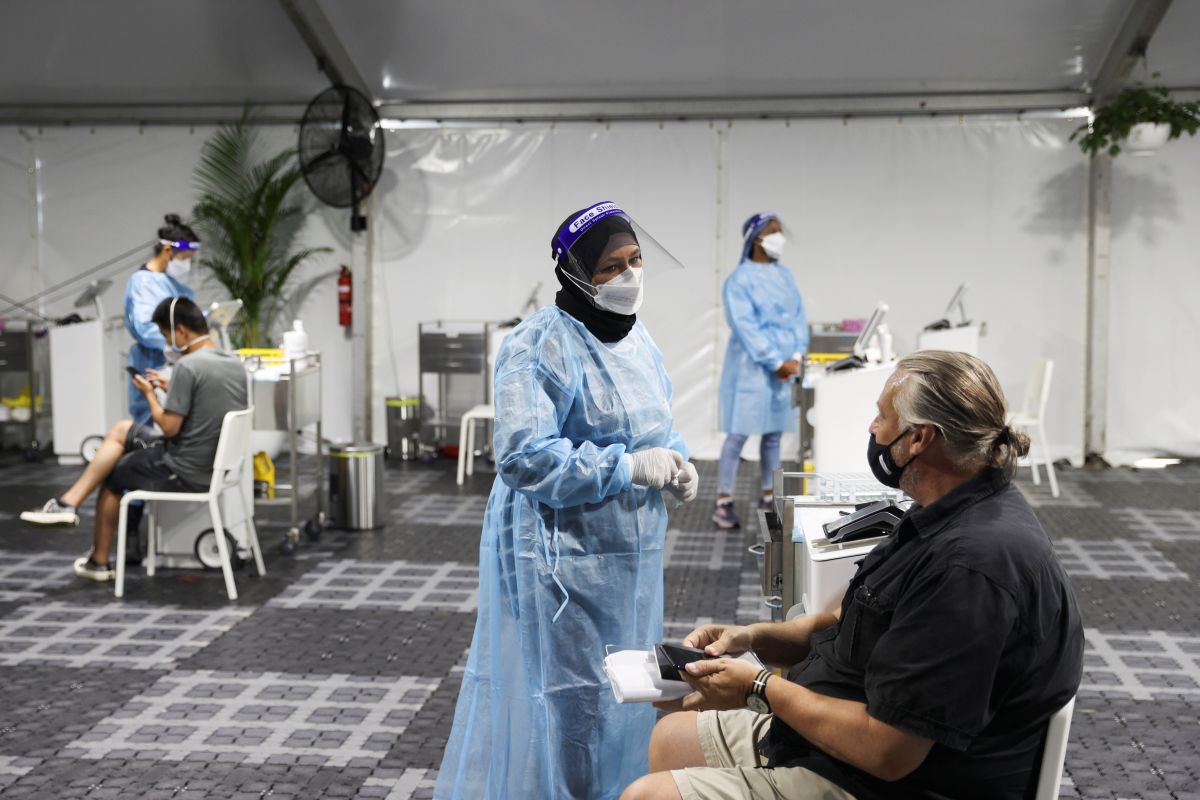The Impact of the COVID-19 Pandemic on International Migration
The COVID-19 pandemic has halted the rising trend of international migration. It has disproportionately affected irregular migrants and refugees, as well as the economies of countries where economic migrants play a major role. The return to the pre-pandemic state is hampered by disparities in access to vaccines, different regulations on arrivals to many countries, a lack of coordination in the recognition of vaccination certificates, and in other areas. The EU can support the development of global standards for accepting certificates. It may also be interested in resuming discussions on changes to international agreements regulating migration and assistance to refugees.
 Fot. LOREN ELLIOTT/Reuters/Forum
Fot. LOREN ELLIOTT/Reuters/Forum
Disruptions to International Mobility
The spread of COVID-19 and the declaration of a pandemic by the WHO on 11 March 2020 caused huge difficulties in international migration. The travel restrictions, lockdowns, and quarantines introduced by state authorities limited the international movement of people (e.g., the number of tourist arrivals globally fell last year by 74% to 396 million from 1.4 billion in 2019). According to the International Organisation for Migration (IMO), by 12 July 2021, almost 110,000 various travel restrictions had been introduced around the world. At the same time, only 980 restricted mobility exceptions were proposed in more than 200 countries and territories.
In 2020, the number of migrants globally was recorded at a level similar as in the previous year—281 million—but this was a decrease by 2 million from the pre-pandemic estimate. Migration to highly developed countries of the OECD decreased by over 30% to 3.7 million in 2020. The restrictions had less effect on the largest group of labour migrants (169 million) and the most on migration for family reunification or international protection.
The number of new asylum applications submitted in 2020 in OECD countries decreased by 31%, the largest single year decrease since the beginning of the 1990s. For the EU, this meant a reduction to 416,600 first-time applications (214,700 fewer than in 2019) and a return to the level before 2015. The pandemic-related restrictions also prompted UNHCR to suspend the resettlement of refugees from camps to safe third countries. As a result, in 2020 only 34,400 people were resettled (a decrease of 64% from 120,000 in 2019), the lowest to date. At the same time, the pandemic did not reduce forced displacements, which increased to 82.4 million in 2020, including 26.4 million refugees.
The COVID-19 pandemic has proved to be a significant factor limiting irregular migration. For instance, according to Frontex, the number of detected attempts to cross the EU’s external border in an irregular manner fell in 2020 by 12% to just over 125,000. In April last year, when the strictest restrictions were in force in the EU countries, fewer than 1,500 people were detected attempting irregular border crossings, and in May, 4,600. This number began to increase along with the lifting of restrictions (to over 20,000 in November 2020). Travel difficulties have made irregular migration even more expensive and dangerous. From March 2020 to July this year, about 5,400 people died attempting such a trip, including at least 3,165 on sea routes to Europe.
The Situation of Migrants
International migrants, especially those with unregulated status, were most affected by the health and economic impacts of the pandemic. In many countries with large concentrations of migrants, they constituted the largest group of people infected with the coronavirus in the first phase of the pandemic (e.g., through June 2020 in Saudi Arabia, 75%; in Singapore, 95%). This was the result of congested living conditions and limited access to healthcare, among other factors. As a result, a number of countries (including in the EU) adopted regulations legalising migrants’ prolonged stay and increasing their access to healthcare. In most cases, however, they were not covered by national immunisation programmes. According to the IMO, as of May 2021, vaccines were provided to only 28% of the 168 surveyed countries. The most difficult situations are in the poorest countries that lack vaccines and in refugee camps. For example, Rohingya refugees in Bangladesh did not have the opportunity to receive the first dose until August this year, and by October only around 50,000 had been vaccinated out of more than 800,000 camp residents.
Migrants were also the group that most often, and first, lost jobs and income during the lockdowns. For the most part, they could not count on the state’s social safety net and government support programmes. Despite this, there has been no global collapse in the value of remittances to developing countries, which fell by only 1.6% to $540 billion in 2020. For example, there was only a slight decrease in transfers from Ukrainian labour migrants working in Poland. Remittances have stabilised because of the gradual opening of economies and the global economic rebound in the second half of the year.
Travel restrictions have meant that, on the one hand, millions of migrants became stranded in destination countries, and, on the other hand, some had to return home prematurely (for example, India evacuated 2.4 million of its citizens). Most often, however, it meant the necessity to postpone migration plans and a situation of “involuntary immobility”. As indicated, among others, by the United Nations, during the pandemic there has been a growing negative attitude towards migration. Health concerns and disinformation have resulted in stigmatisation of migrants and increased xenophobic attitudes.
International Impact
Reduced migration has also affected host countries and the international economy, especially sectors reliant on human mobility. Countries with a high proportion of migrants faced labour shortages in critical sectors such as healthcare (e.g. 33% of UK doctors are foreigners) and agriculture (46% of workers in the U.S. are migrants; 11% in Italy), and services (23% of workers in the U.S.; 18% in Germany). In a few cases, the reduction in migration has translated into negative demographic trends, such as the decline in the German population in 2020 for the first time in a decade, while Australia recorded net emigration for the first time since 1945.
Partial lifting of restrictions causes a renewed increase in international mobility, both regular and irregular. Through October this year, Frontex has recorded 136,000 irregular attempts to cross the EU border, which is more than in all of 2020. The situation on the Polish-Belarusian border has been a new phenomenon of a state creating irregular migration routes as an instrument of foreign policy. At the same time, it demonstrates that people who have been deprived of the possibility of leaving are looking for new routes to reach developed countries. The recent events on the EU’s eastern and southern borders also indicate a tightening of the approach to migration in Europe, which is more focused on border protection and limiting irregular migration.
Conclusions and Perspectives
Limiting migration to developed countries has contributed to the deepening of some economic problems and increasing labour shortages in critical sectors that will slow the recovery of their economies after the pandemic. The introduced travel restrictions reduced regular and irregular migration and had an overall negative impact on the situation and rights of migrants and refugees. This will hinder the implementation of the UN Sustainable Development Goals, including Priority 10.7 on enhancing legal and safe migration. The lifting of pandemic-related restrictions in 2021 has made it possible to partially resume travel, but the return to the pre-pandemic situation is complicated, among others, by inequalities between countries in access to vaccines, different policies regarding the conditions of entry into different countries, and the lack of universally recognised vaccination certificates. Obstructing legal migration for residents of developing countries and increasing its costs will induce more people to attempt irregular migration.
Developed countries, including the EU, should support the unblocking of legal migration channels, including by financing vaccinations in the poorest countries and supporting international efforts (including at the WHO forum) to develop a universal vaccination certificate and standardise requirements for travellers. Support in refugee camps should also be stepped up and the resettlement programme resumed, making up for delays in helping vulnerable people. EU countries can also launch information campaigns and integration programmes to counteract disinformation and negative attitudes towards migration. Restrictions on the rights of migrants during the pandemic, the tightening of developed countries’ policies towards migrants and refugees, and especially the use of mass migration in the foreign policy of certain countries, may encourage the EU to engage in the international discussion on the need to update the Geneva Convention of 1951 and the Global Migration Pact of 2018 to better take into account the challenges of the post-COVID-19 world.


